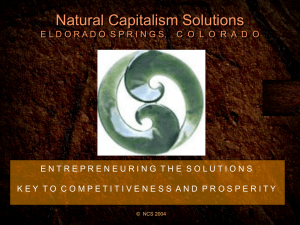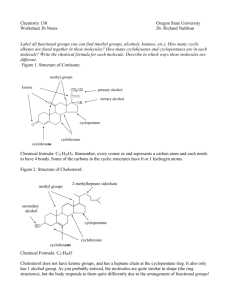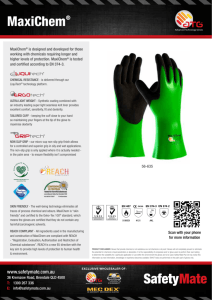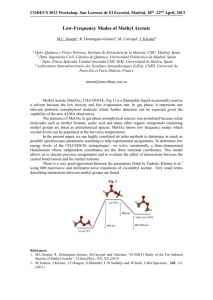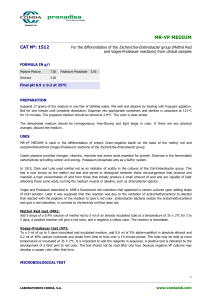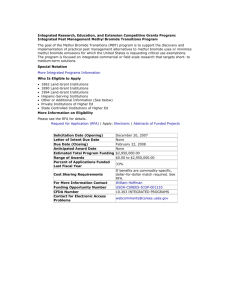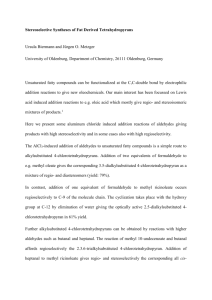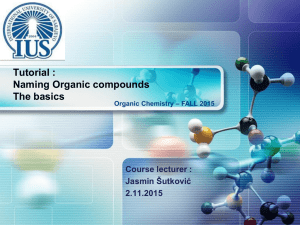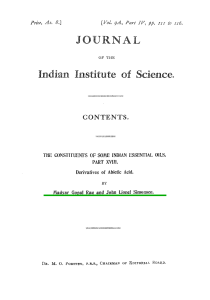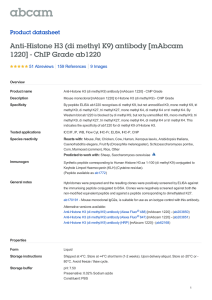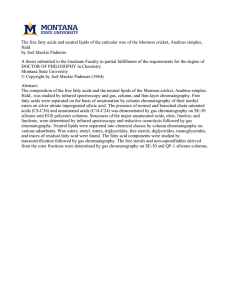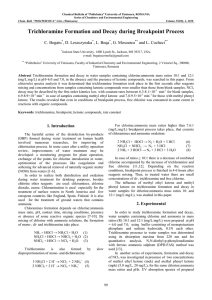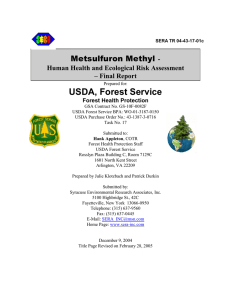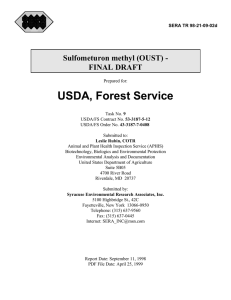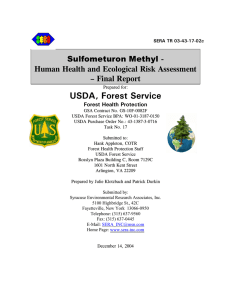Ecological Footprint
advertisement
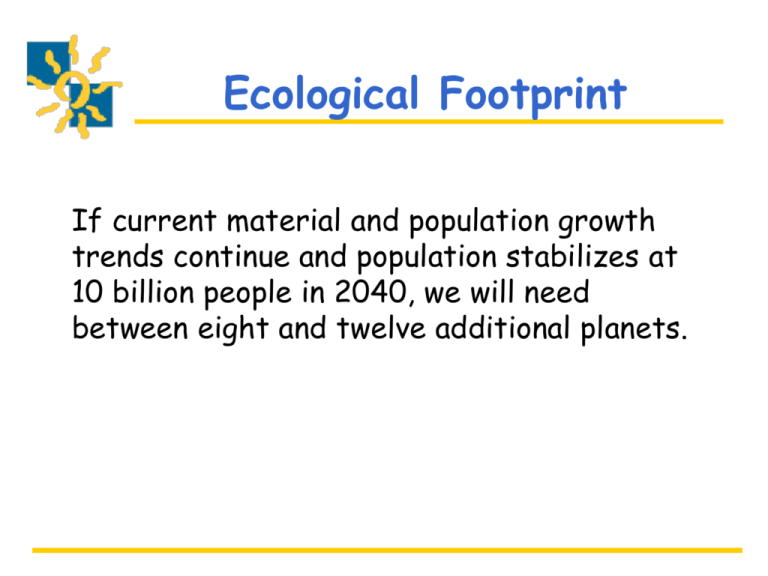
Ecological Footprint If current material and population growth trends continue and population stabilizes at 10 billion people in 2040, we will need between eight and twelve additional planets. World Carbon Emissions, 1950-2000 From Fossil Fuel Burning Million Tons 7,000 6,000 5,000 4,000 3,000 2,000 1,000 0 1950 1960 1970 1980 1990 2000 World Mean Temperature 15.8 15.6 15.4 15.2 15 14.8 14.6 14.4 14.2 14 13.8 13.6 Source: State of the World, World Watch Institute 700 600 500 400 300 200 100 0 1950s 1960s Economic losses 1970s 1980s 1990s Number of major catastrophes Underbelly of our Industrial System ENVIRONMENTAL DEGRADATION Global Warming SOCIAL INEQUITY & POVERTY *M = Manufactured Capital Habitat Loss Decimated Biodiversity Erosion Deforestation Widespread Pollution Waste to Landfill Poverty Child Labor Malnutrition Injustice Cancer Unclean Water Human Rights Violations Toxic Chemical Exposure The Concept of the Funnel Decline of Living Systems Margin for Action Population x Affluence x Technology Environmental Concerns •Mass extinctions •Deforestation & soil erosion •Air & water pollution •“Super” bacteria, viruses, and insects •Dwindling natural resources •Cancer rates increasing •Reproductive disorders increasing •Fisheries collapsing •Water tables falling •Climate Change Extinctions •51% of freshwater animal species are declining in number. •One in four vertebrate species are in sharp decline or facing serious pressure from human activities. •One of every eight known plant species is threatened with extinction or is nearly extinct. •One in ten tree species—some 8,750 of the 80,000 to 100,000 tree species known to science—are threatened with extinction. •The overall rate of extinction is estimated to be 1,000 to 10,000 times higher than it would be naturally. Acid Rain Rain forest destruction Fisheries collapse Global warming Forest loss Toxicity Water Pollution Nuclear Plants Air pollution Jobs vs. environment debates Flooding Ground water contamination Energy Sources PRINCIPLES OF SUSTAINABILITY Hunge r Monocultures The Purpose of The Natural Step: To develop and share a common framework comprised of easily understood, scientifically-based principles that can serve as a compass to guide society toward a sustainable future. © 1996 Paul Hawken, Karl-Henrik Robèrt, and The Natural Step System Condition No. 1 Substances from the Earth's crust must not systematically increase in the biosphere This means: fossil fuels, metals and other minerals must not be extracted at a faster rate than their redeposit and regeneration in the the Earth's crust. System Condition No. 2 Substances produced by society must not systematically increase in nature HALOGENATED COMPOUNDS chlorodifluoromethane chlorotrifluoromethane dichlorofluoromethane chloromethane trichlorofluoromethane dichloroethylene Freon 113 methylene chloride chloroform 1,1,1 – trichloroethane carbon tetrachloride trichloroethylene chloropentane chlorobenzene iodopentane 3-methyl-1-iodobutance chloroethylbenzene dibromodichloromethane dichlorobenzene chlorodecane trichlorobenzene ALDEHYDES acetaldehyde methyl propanal n-butantal methylbutanal crotoaldehyde n-penanal n-hexanal furaldehyde n-heptanal benzaldehyde n-octanal phenyl acetaldehyde n-nonanal methyl furaldehyde n-decanal n-undecanal n-dodecanal KETONES acetone methyl ethyl ketone methyl propyl ketone methyl vinyl ketone ethyl vinyl ketone 2-pentanone methyl pentanone methyl hydrofuranone 2-methyl-3-hexanone 4-heptaonone 3-heptaonone 2- heptaonone methyl heptaonone furyl methyl ketone octanone acetaphenone 2-nonanone 2-decananone alkylated lactone phthalide OXYGENATED ISOMERS C4H6O C4H8O C5H10 O C4H6O2 C6H12 O C7H10 O C7H14 O2 C6H6O2 C6H14 O2 C6H16 O C7H8O2 C7H10 O2 C9H18 O C8H6O2 C10H12 O2 C10H14 O This means: substances must not be produced faster than they can be broken down and be reintegrated into the cycles of nature or be deposited in the Earth's crust C10H16 O C10H18 O C10H20 O C10H22 O C9H8O2 C11H20 O ALCOHOLS methanol isoproponal n-proponal 1-butanol 1-pentanol x-furfuryl alcohol 2-ethyl-1-hexanol phenol 2,2,4-trimethylpenta-1,3-diol x-terpineol ACIDS acetic acid decanonic acid SULFUR COMPOUNDS System Condition No. 3 The physical basis for the productivity and diversity of nature must not be systematically deteriorated. This means: the productive surfaces of nature must not be diminished in quality or quantity, and we must not harvest more from nature than can be recreated or renewed. System Condition No. 4 There needs to be fair and efficient use of resources with respect to meeting human needs. This means: basic human needs must be met with the most resource efficient methods possible, including equitable resource distribution. Income Disparities Percentage Richest 20% 90 80 70 60 50 40 30 20 10 0 Poorest 20% 86.0 70.2 2.3 1960 1.1 1970 1980 1990 1994 Four System Conditions 1. What we take from the Earth’s crust 1. What we make in the lab 2. What we take from land and sea 3. How efficient and equitable we are Applying the System Conditions Does this decision: 1. Decrease dependence on oil, gas, and metals? 2. Decrease dependence on compounds produced by society? 3. Increase the productivity and biodiversity in nature? 4. Increase the efficiency and equity with which resources are used? Yes No ___ ___ ___ ___ ___ ___ ___ ___ Profitability Cl Re osed ne R w a eso ble ur En ce L erg oo y S ps ou rce s Total Cost Accounting Sustainable y fits nit ne m u Be m er Co old & eh es tak loye dS p c e Em lan rs, B a e s to In v Zero Waste Work with Biological & Ecological Cycles Self-Replenishing High Quality of Life Eco-System Services Healthy Communities Social Merit Health Crises Malnutrition Nature Viewed as Raw Materials to be Extracted Unsustainable Externalization of Environmental & Social Costs e te issio as W Em n & to tio ed uc rm rod sfo , P Tran on cti els tra Fu Ex ssil Fo Ozone Depletion Global Warming Gross Inequities Resource Conflicts nc Declining Resources Altered Bio/Geochemistry Lo ov w es er t C L o os ya t L lty ab to or Co tak mm es un Pre itie ce de s Environmental Integrity ns Tomorrow’s Material Cycle Tomorrow’s profit will come from design, not matter Natural Resources Reduce Use of Natural Resources Goods and Services Recover Technical Nutrients Closing the Material Loop Key Concept: Material recovery starts and ends with great product design Goals: Need Less material inputs throughout product life Make use of recovered materials Make it easy to recover materials Goals: Find sustainable sources of technical nutrients Decreasing Resource Use By Design • Design for Efficient Production • Design for Efficient and Effective Use •Closing Design Efficient Recovery the for Loop Recapture value from materials Learn from experience to improve future design • Take-back Logistics Business Leaders Higher Education Network for Business Innovation and Sustainability/NW Government Agencies Community Stakeholders Non-Profits Building Community Collaboration to Support Sustainable Prosperity catalyzing and enabling increased business to business collaboration; i.e. best practices, IE linking sustainable business projects with the teaching and research capacities being developed in higher education institutions, developing informed relationships between businesses and non-profits that profitably reward sustainability in the marketplace, Collaboration between business and government that facilitate eco-efficiency, innovation and reward sustainable practices Interdisciplinary Support for Sustainable Business: Research, Teaching & Action Learning Projects Business Management Environmental Information Systems Marketing Green Building Architecture Life Cycle Product Design Accounting FINANCIAL STRENGTH through implementation of sustainable business practices Biomimicry Economics Organization Development Economic Leadership Industrial Ecology Urban & Regional Planning Environmental Engineering Bioregional Natural Resource Management Green Chemistry Objectives Political Science Environmental Social ENVIRONMENTAL INTEGRITY SOCIAL MERIT through use of technologies and strategies through promoting socially that reduce material use, energy use, and environmentally toxins and waste preferable products and services Rural and Urban Sociology Human Development Ecopsychology Geology, Hydrology & Atmospheric Sciences Science/Technology for renewable and Efficient energy use Biological and Physical Sciences Community Development Information Technology Sustainable Agriculture Communications Specialists Bioregional Geography Social Sciences Figure 2 By Karl Ostrom Network for Business Innovation & Sustainability An intensive one-day workshop S P S USTAINABLE URCHASING TRATEGIES Using the Natural Step Framework Thursday, May 1, 2003 Sustainable Business Four strategies to put you on the road to sustainability Strategy Value from Ecosystems Material to Information Connect to Value Chain Connect to Community — Knowledge intensive — Green products — Stakeholder agenda — New business opportunities — Value per volume output — Supply chain improvement — Local solutions — Renewable materials — Value per unit capital — Products to Services — Creative partnerships — Renewable energy — Reduce footprint — Remanufactu ring — Trust — Offsets — Material per customer — Lower operating costs — Biomimicry
